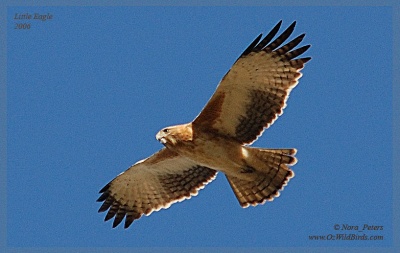| Line 1: | Line 1: | ||
| + | [[Image:Little_Eagle.jpg|thumb|500px|right|Photo by tannin <br/>Shot at Clunes, Victoria, Australia ]] | ||
;[[: Category:Hieraaetus|Hieraaetus]] morphnoides | ;[[: Category:Hieraaetus|Hieraaetus]] morphnoides | ||
| − | + | ''Aquila morphnoides'' | |
[[Image:39712Little-Eagle_by_Nora.jpg|thumb|400px|right|Photo by Nora<br/>Location: Melton, Melbourne]] | [[Image:39712Little-Eagle_by_Nora.jpg|thumb|400px|right|Photo by Nora<br/>Location: Melton, Melbourne]] | ||
==Identification== | ==Identification== | ||
Revision as of 23:07, 22 December 2009
- Hieraaetus morphnoides
Aquila morphnoides
Identification
Short broad head, long tail, square-cut at the tip when closed. Heavily feathered legs. Plumage varies from light to dark brown, with a pale broken 'M' across the upperparts, which is visible from a distance. There is also a pale M-shaped band on the underwing. It has long broad wings, spanning over 1m. The female is larger than the male.
Distribution
New Guinea and Australia except Tasmania.
Taxonomy
Aquila vs. Hieraaetus
Hieraaetus species are sometimes placed in a broader defined Aquila (e.g. Clements, 2005). Sibley & Monroe (1996) and Howard & Moore (2003) retain the placement in Hieraaetus, and the Opus awaits further clarification.
Subspecies
Two subspecies are recognized, morphnoides and weiskei.
Habitat
Scrub and woodland, often close to water.
Behaviour
Diet includes rabbits, other live mammals and insects.
Nests are built in mature living trees in open woodland or tree-lined watercourses. It is an open bowl of twigs and branches, lined with green leaves. The female mainly broods the young and feeds the young small pieces of food bill to bill. The male hunts for food for the young. The male will incubate while the female eats the food he has brought for her.





